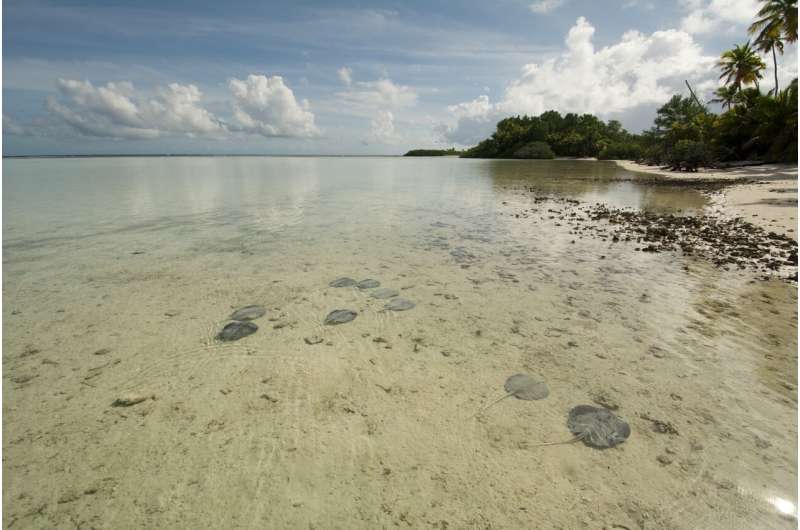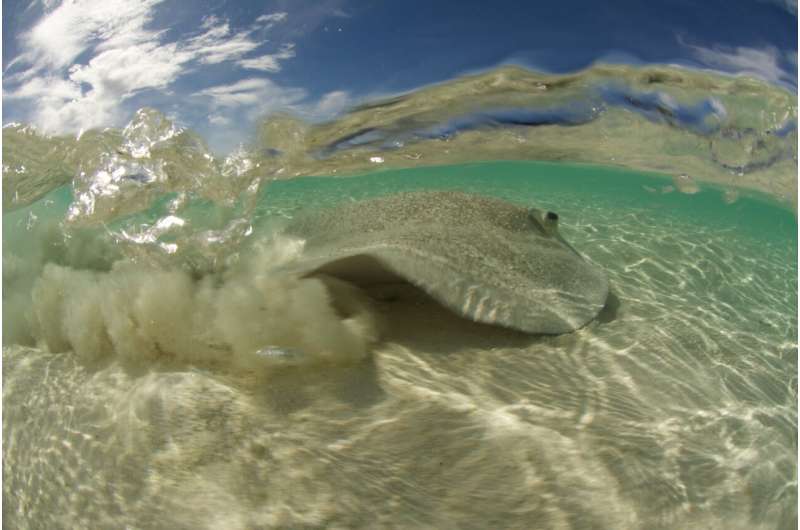The sanctuary of the shallows: Climate change could affect where Seychelles' stingrays choose to live

Stingrays are in a lot of trouble, mainly because of overfishing. Scientists from the Save Our Seas Foundation D'Arros Research Centre (SOSF-DRC) and the South African Institute for Aquatic Biodiversity have been working to discover more about the lives of stingrays in Seychelles. Their office is the newly protected D'Arros Island and St Joseph Atoll. Here, soft white sands lead into shades of turquoise and deep blue. Below the waves, this pristine ecosystem is home to biodiverse coral reefs.
In a new paper published in the journal Frontiers in Marine Science, the scientists dived into the importance of this varied habitat for vulnerable stingrays. Sixty individuals from three species of stingray that live in St Joseph Atoll year-round were tracked for a year on average. Environmental factors, like the tides and temperatures, were recorded during this time.
St Joseph Atoll is the perfect place for such research. Consisting of two major habitat types, a shallow uninterrupted reef flat and a deeper enclosed lagoon, it's an important nursery area for the three study species: the cowtail stingray, the mangrove whipray and the porcupine whipray. Scattered over the reef flats are sea-grass beds that are sometimes exposed and sometimes covered by water.
To follow the stingrays' movements here, the researchers used a technique called passive acoustic telemetry. They tagged 20 stingrays from each species with acoustic transmitters. Forty underwater tracking stations were spread across the reef-flat and lagoon habitats. These stations pick up the unique sound pulses that are emitted by each transmitter.
They found that stingrays prefer the safety of the shallows. But environmental extremes such as very low tides or particularly high or low water temperatures push these rays into deeper waters, where they are at risk from larger, predatory sharks. Conditions here are more stable, however, so it is likely that their preferred habitat will change as the climate changes and extremes become more common.
Changes haven't gone unnoticed at D'Arros Island and St Joseph Atoll. After severe coral bleaching that occurred across the Western Indian Ocean, these resilient reefs are showing signs of recovery. The Seychellois celebrate sanctuaries for marine life and in March 2020, through the Seychelles Marine Spatial Plan initiative, their government designated the waters surrounding D'Arros Island and St Joseph Atoll as zone 1 and zone 2 equivalent marine protected areas, respectively.

This protection recognizes the importance of D'Arros and St Joseph for endangered species and the wider ecosystem, which Chantel Elston, the paper's lead author and an SOSF project leader, has experienced at first hand.
"Stingrays are really important for keeping oceans healthy, especially in tropical places like Seychelles," she says. "This research helps to present further evidence that the isolated St Joseph Atoll provides suitable habitat for threatened stingrays and that the newly announced marine protected area will have real conservation benefits."
Research like this helps us to protect vulnerable groups like stingrays more effectively. As Helena Sims, SOSF Seychelles Ambassador, explains, "When you know what the priority habitats for vulnerable species are and how and when they move around, management plans can be developed for their conservation." And when it comes to marine management, the Seychellois are ahead of the game. This last batch of marine protected area designations means that 30% of Seychelles' waters is now protected, 10 years ahead of the international target.
As Helena puts it, "That the people of Seychelles are endowed with a pristine environment is not debated. In fact, the right to live in a healthy environment and the duty of citizens to protect, preserve and improve the environment and its cultural heritage are embodied in the Republic's constitution." There's a very strong conservation ethic here, with the government focused on making ecological investments for the next generations.
The nation's beauty has captured the heart of the Save Our Seas Foundation's Founder, Abdulmohsen Abdulmalik Al-Sheikh, who said, "I am constantly amazed by the abundant natural wonder in Seychelles and what this new research has revealed about the behavior of rays at D'Arros is no exception. Their intricate lives are fascinating and highlight the importance of sites like St Joseph for safeguarding the natural heritage of Seychelles."
More information: Chantel Elston et al, Stingray Habitat Use Is Dynamically Influenced by Temperature and Tides, Frontiers in Marine Science (2022). DOI: 10.3389/fmars.2021.754404
Provided by Save Our Seas Foundation





















